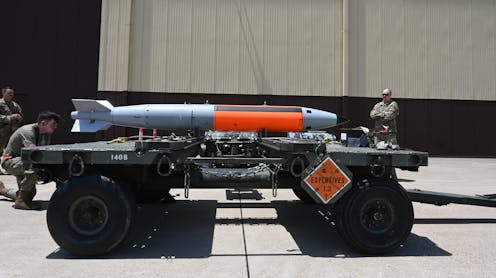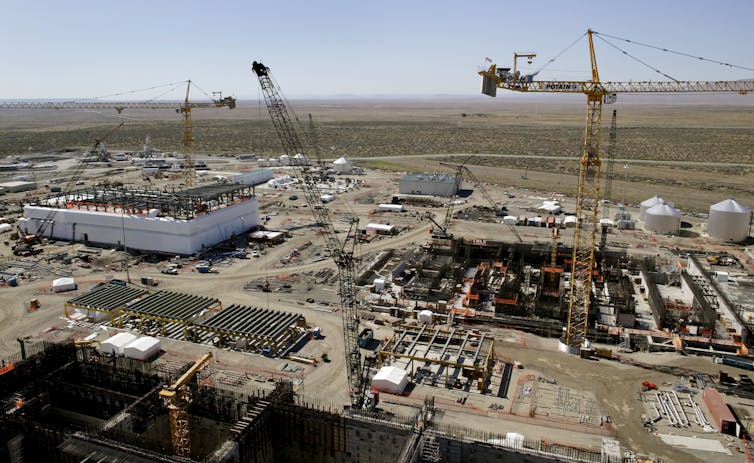
The U.S. Department of Energy was created in 1977 by merging two agencies with different missions: the Atomic Energy Commission, which developed, tested and maintained the nation’s nuclear weapons, and the Energy Research and Development Administration, a collection of domestic energy research programs.
Today the department describes itself, with what some might call understatement, as “one of the most interesting and diverse agencies in the Federal government.” Its annual budget of roughly US$50 billion supports some 14,000 employees and 95,000 contractors.
The secretary of energy advises the president on energy policy and guides energy and nuclear weapons production initiatives. As researchers who study energy efficiency and national security and who work with the Energy Department, we have seen that its secretary needs to be able to think long-term and make strategic decisions, sometimes with incomplete information. A good grasp of science, engineering and energy technology is helpful, as are the abilities to lead a large organization and to work with Congress.
Scientific research and development
The Energy Department’s Office of Science supports a large portion of basic U.S. scientific research, including fusion energy, particle physics, chemistry and material science. Together with the agency’s Office of Energy Efficiency and Renewable Energy, the agency manages a research portfolio with a budget of roughly $12 billion – nearly as large as that of the U.S. National Science Foundation, the other major federal funder of basic research.

Many energy secretaries have made their greatest marks by supporting and directing research. For example, during the first Trump administration, Rick Perry recognized potential cyber-terrorism risks to U.S. energy infrastructure and supported research in artificial intelligence. This led to the creation of the agency’s Office of Cybersecurity, Energy Security and Emergency Response.
Steven Chu, who led the department from 2009 to 2013 under former President Barack Obama, initiated the Advanced Research Projects Agency–Energy, or ARPA-E, a division that focuses on new, cutting-edge energy innovations at stages too early to attract private-sector investment. ARPA-E projects have led to the creation of over 100 new companies and to over 1,000 patents on a wide range of energy technologies, including hybrid-electric aircraft, carbon dioxide capture from the air and improved electricity transmission.
Most recently, during the Biden administration, Jennifer Granholm focused on working with business and industry to deploy clean energy technologies in support of U.S. climate goals. This effort has included offering grants, loans and rebates, filling gaps in supply chains, and promoting domestic manufacturing of components such as advanced batteries and solar panels.
Research payoffs
Much of the research that the Energy Department funds can take years to produce results with commercial applications, but it has had some notable successes.
Since the late 1970s, the agency has invested significantly in shale oil research. Combined with additional research and development by private energy companies, the Energy Department helped develop fracking and horizontal drilling. These technologies have revolutionized petroleum and natural gas production and made the U.S. the world’s largest producer of oil and natural gas.
Energy Department funding supported the commercialization of LED lights, which are highly efficient and long-lasting. It also has enabled breakthroughs in other energy-efficient technologies, solar and wind energy production, battery technology, and geothermal and wave energy. The agency provides critical support for research on nuclear fusion, which promises to be a clean and abundant source of energy, although it is far from commercialization today.
There also are large swaths of U.S. energy policy that the Energy Department doesn’t control. For example, leases and permits for energy production on public lands and in federal waters are awarded by the Department of the Interior.
The Federal Energy Regulatory Commission, an independent agency, controls the siting of oil and natural gas pipelines and interstate electricity transmission lines. Another independent agency, the Nuclear Regulatory Commission, licenses and regulates the nuclear power industry.
Still, energy secretaries often champion broad strategies that overlap with the mission and authority of other federal departments and agencies.
Nuclear weapons and national security
The Energy Department’s other mission – developing and maintaining nuclear weapons – is steered by the National Nuclear Security Administration, a semi-autonomous agency within the department. Organizationally, the NNSA is the great-grandchild of the Manhattan Engineer District – the post-World War II incarnation of the Manhattan Project that developed the first U.S. atomic weapons.
The NNSA is headed by an administrator who also serves as undersecretary of energy for nuclear security, a Senate-confirmed position. When the energy secretary’s background is in domestic energy – like oil executive Chris Wright, President-elect Trump’s choice to head the agency – the leader of the NNSA is likely to be especially influential on national security issues.
Of the Energy Department’s 17 national laboratories, three – Los Alamos, Sandia and Lawrence Livermore – are officially overseen by the NNSA. Others receive significant NNSA funding and play roles in maintaining the U.S. nuclear arsenal.
The NNSA also oversees experimental and testing facilities and other sites involved in the design, production and testing of nuclear weapons. It is responsible for storing and securing warheads that are not deployed at military installations, and for dismantling retired warheads.
A separate office, Environmental Management, oversees the cleanup of nuclear research and production sites, some of which have contamination dating back to World War II. The largest environmental cleanup program in the world, it consumes about $8 billion annually – one-sixth of the agency’s entire budget. It handles large amounts of radioactive wastes, spent nuclear fuel, excess plutonium and uranium, and contaminated facilities, soil and groundwater.

The NNSA plays a critical role in preventing the spread of nuclear weapons and the materials and technologies needed to make them. It is part of the intelligence community with deep technical expertise, and responds to nuclear and radiological threats globally.
Finally, the NNSA designs and supports the nuclear reactors that propel Navy ships and submarines around the globe.
Historically, the NNSA administrator has had a great deal of autonomy. Most administrators bring deep technical and policy expertise to the job. Some are retired Navy or Air Force officers who have worked with nuclear weapons or naval propulsion systems. Others are researchers with long tenures at Department of Energy laboratories.
Aging weapons, sites and workers
The next energy secretary and NNSA administrator will face major technical, economic and management challenges. The NNSA has been working for years to modernize nuclear weapons production infrastructure, which is aging and underfunded. At the same time, the Energy Department is working with the Defense Department to update U.S. nuclear weapons and strategic nuclear forces – bombers, ballistic missiles and submarines – to deter threats from other nations. This effort could cost up to $1.7 trillion over several decades.
Many of the NNSA’s major modernization projects are over budget and years behind schedule. The U.S. Government Accountability Office recently reported that the NNSA needs to improve its program management practices in order to control costs and successfully execute these expensive initiatives.
The incoming administration will also have to recruit and sustain a highly skilled workforce for nuclear security programs. Many retirement-eligible employees have already left the agency. More will exit over the next four years, often drawn by private-sector salaries and perceived better working conditions.
While the Energy Department touts its high-tech laboratories and research facilities, the agency’s people are equally critical to its mission.
This story is part of a series of profiles of Cabinet and high-level administration positions.
Valerie Thomas receives funding from the U.S. Department of Energy for research on energy efficiency in U.S. pulp and paper production.
Margaret E. Kosal is a joint faculty appointee to the U.S. Department of Energy's Savannah River National Laboratory (SRNL). She has received funding from the department through the SRNL.
This article was originally published on The Conversation. Read the original article.







